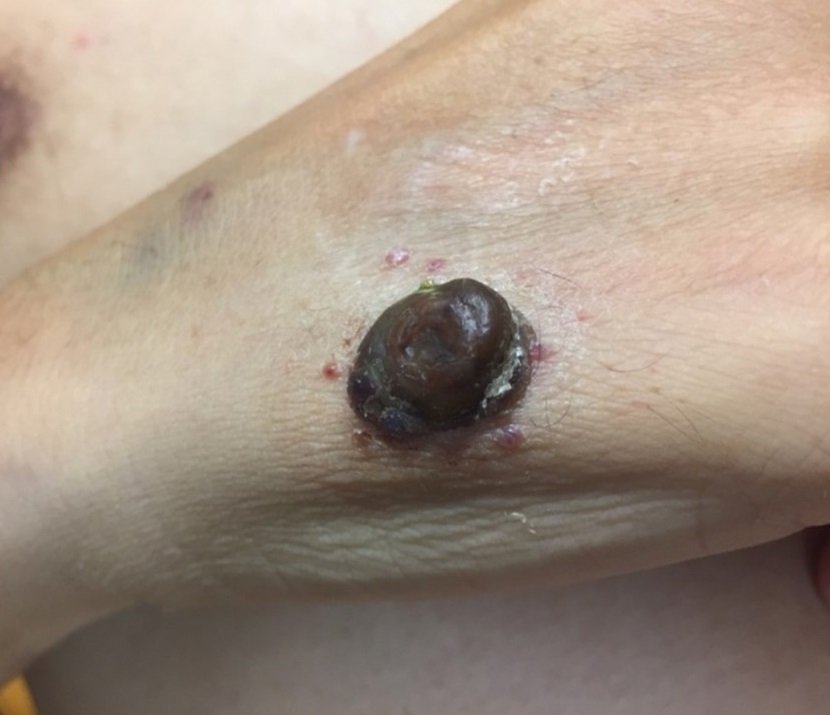Bacillary angiomatosis in renal transplant recipient and the helpful investigation by PCR to identified Bartonella spp
Keywords:
bacillary angiomatosis, renal transplant recipient, PCRAbstract
A 37-year-old Thai man, with end stage renal disease, who underwent renal transplantation, presented with a 1-month history of solitary, asymptomatic, rapidly-growing fragile erythematous-violaceous nodule on the dorsum of right hand. He also had subacute fever, fatigue and weight loss of 3 kilograms in 2 weeks. Skin excisional biopsy was performed and revealed pyogenic granuloma like lesion. Bacterial identification by PCR technique showed Bartonella henselae. He also had a history of contact with many cats near his home.
Bacillary angiomatosis (BA) is angioproliferative disease caused by Bartonella henselae or Bartonella quintana infection found in immunocompromised host especially HIV infection and organ transplant patients. The disease has potentially life-threatening course yet easily treatable. PCR has higher sensitivity, specificity and need shorter time than other methods to identify Bartonella spp. Treatment of choice is macrolide or doxycycline.
References
Akram SM, Bhimji SS. Mycobacterium Chelonae. StatPearls. Treasure Island (FL): StatPearls Publishing StatPearls Publishing LLC. 2018.
Diniz LM, Medeiros KB, Landeiro LG, Lucas EA. Bacillary angiomatosis with bone invasion. An Bras Dermatol 2016; 91: 811-4.
Nikam BP, Vijayendran N, Jamale V, Kale M. Bacillary Angiomatosis in an Immunocompetent Individual. Indian Dermatol Online J 2018;9:205-6.
Fulchini R, Bloemberg G, Boggian K. Bacillary Angiomatosis and Bacteremia due to Bartonellaquintana in a Patient with Chronic Lymphocytic Leukemia. Case Rep Infect Dis 2013;2013:694765.
Orsag J, Flodr P, Melter O, Tkadlec J, Sternbersky J, Hruby M, et al. Cutaneous bacillary angiomatosis due to Bartonellaquintana in a renal transplant recipient. TransplInt 2015;28:626-31.
ShamekhiAmiri F. Bartonellosis in Chronic Kidney Disease: An Unrecognized and Unsuspected Diagnosis. TherApher Dial 2017; 21:430-40.
C. Moulin JK, B. Ranchin, C. Chauvet, Y. Gillet, E. Morelon, S. Euvrard. Cutaneous bacillary angiomatosis in renal transplant recipients report of three new cases and literature review. transplant infectious disease 2012; 14:403-9.
Diddi K CR, Sharma N, Dhawan B. Strategy for identification & characterization of Bartonellahenselae. Indian J Med Res 2013; 137:380-7.
Prutsky G, Domecq JP, Mori L, Bebko S, Matzumura M, Sabouni A, et al. Treatment outcomes of human bartonellosis: a systematic review and meta-analysis. Int J Infect Dis 2013;17: e811-9.

Downloads
Published
How to Cite
Issue
Section
License
เนื้อหาและข้อมูลในบทความที่ลงตีพิมพ์ในวารสารโรคผิวหนัง ถือเป็นข้อคิดเห็นและความรับผิดชอบของผู้เขียนบทความโดยตรงซึ่งกองบรรณาธิการวารสาร ไม่จำเป็นต้องเห็นด้วย หรือร่วมรับผิดชอบใดๆ
บทความ ข้อมูล เนื้อหา รูปภาพ ฯลฯ ที่ได้รับการตีพิมพ์ในวารสารโรคผิวหนัง ถือเป็นลิขสิทธิ์ของวารสารฯ หากบุคคลหรือหน่วยงานใดต้องการนำทั้งหมดหรือส่วนหนึ่งส่วนใดไปเผยแพร่ต่อหรือเพื่อกระทำการใดๆ จะต้องได้รับอนุญาตเป็นลายลักอักษรจากบรรณาธิการวารสารโรคผิวหนังก่อนเท่านั้น


